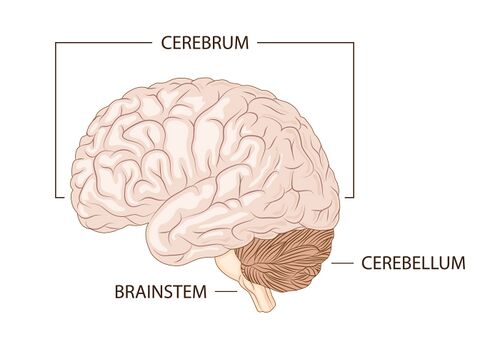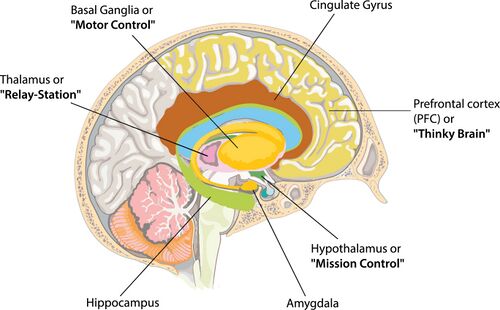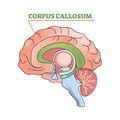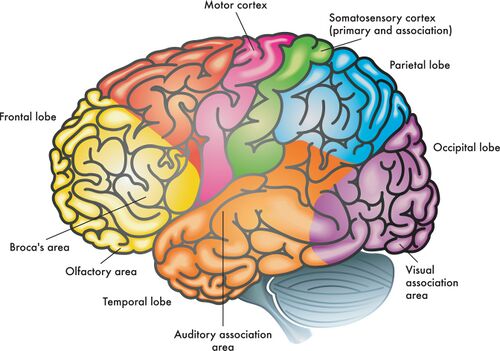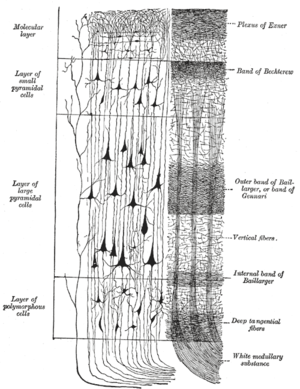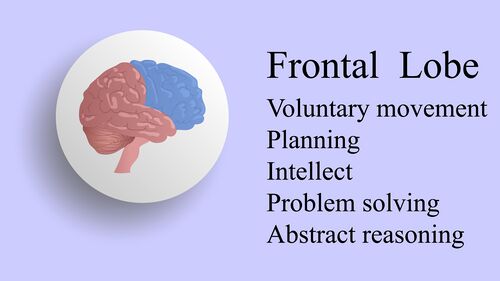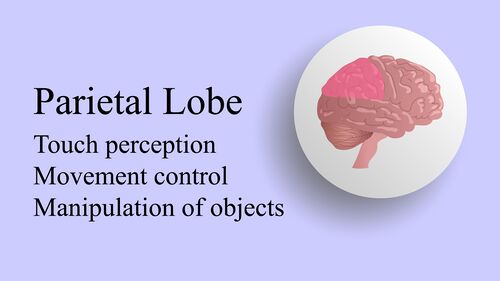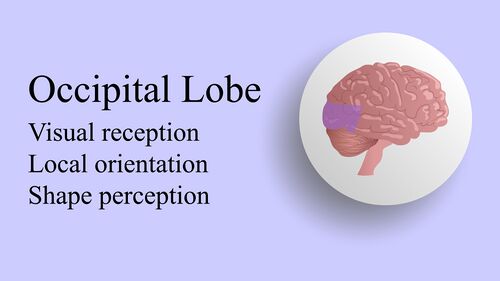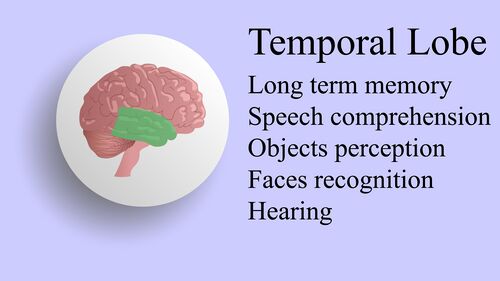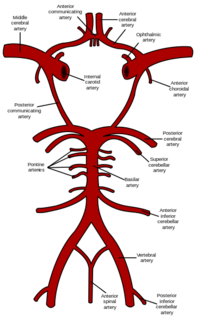Cerebral Cortex: Difference between revisions
No edit summary |
No edit summary |
||
| Line 13: | Line 13: | ||
The cerebrum is composed of two '''cerebral hemispheres''' (i.e. the right and left hemispheres). The two hemispheres are connected via subcortical pathways, including the '''[[Corpus Callosum|corpus callosum]]'''. The corpus callosum is a thick tract of nerve fibres that facilitates communication between each side of the brain. These connections, as well as the connections from the cerebral cortex to the [[brainstem|'''brainstem''']], [[Spinal cord anatomy|'''spinal cord''']] and subcortical nuclei deep within the cerebral hemisphere, form the white matter of the cerebral hemisphere. The '''deep nuclei''' include structures such as the [[Basal Ganglia|'''basal ganglia''']] and the [[thalamus|'''thalamus''']]. | The cerebrum is composed of two '''cerebral hemispheres''' (i.e. the right and left hemispheres). The two hemispheres are connected via subcortical pathways, including the '''[[Corpus Callosum|corpus callosum]]'''. The corpus callosum is a thick tract of nerve fibres that facilitates communication between each side of the brain. These connections, as well as the connections from the cerebral cortex to the [[brainstem|'''brainstem''']], [[Spinal cord anatomy|'''spinal cord''']] and subcortical nuclei deep within the cerebral hemisphere, form the white matter of the cerebral hemisphere. The '''deep nuclei''' include structures such as the [[Basal Ganglia|'''basal ganglia''']] and the [[thalamus|'''thalamus''']]. | ||
The external surface of the brain is highly convoluted, with many folds. This distinct shape evolved as the volume of our cortex increased more rapidly than our cranial volume. If the cerebral cortex was removed and unfolded, it would cover several yards or metres | The external surface of the brain is highly convoluted, with many folds. This distinct shape evolved as the volume of our cortex increased more rapidly than our cranial volume. If the cerebral cortex was removed and unfolded, it would cover several yards or metres: | ||
* | * the grooves of the cortex are called '''sulci'''. The sulci separate the elevated regions or ridges, which are called '''gyri'''. | ||
* | * there are three main sulci in each hemisphere: (1) '''central sulcus''', (2) '''parieto-occipital sulcus''' and (3) '''lateral fissure'''. | ||
* | * each hemisphere is divided into '''four lobes''': '''[[Frontal Lobe|frontal]]''', '''[[Parietal Lobe|parietal]]''', '''[[Temporal Lobe|temporal]]''' and '''[[Occipital Bone|occipital]]''' lobes.<ref name=":0">Jawabri KH, Sharma S. Physiology, Cerebral Cortex Functions. StatPearls Publishing; 2024 Jan. https://www.ncbi.nlm.nih.gov/books/NBK538496/</ref><ref name=":3">Javed K, Reddy V, Lui F. Neuroanatomy, Cerebral Cortex. StatPearls Publishing; 2024 Jan-. Available from: https://www.ncbi.nlm.nih.gov/books/NBK537247/</ref> They are named after the overlying [[Skull|cranial bones]]. | ||
<gallery> | <gallery> | ||
File:Lobes of the brain.jpeg|Lobes of the brain | File:Lobes of the brain.jpeg|Lobes of the brain | ||
File:Cerebral cortex side view.png|Cerebral cortex | File:Cerebral cortex side view.png|Cerebral cortex surface anatomy | ||
File:Sulci and gyri.jpeg|Note the raised sulci and depressed gyri forming the surface of the cerebrum | File:Sulci and gyri.jpeg|Note the raised sulci and depressed gyri forming the surface of the cerebrum | ||
File:Corpus callosum in situ.jpeg|The area in green | File:Corpus callosum in situ.jpeg|The area in green is the corpus callosum | ||
</gallery> | </gallery> | ||
== Cerebral Cortex == | == Functions and Regions of the Cerebral Cortex == | ||
The cerebral cortex is the outer layer of the cerebral hemispheres. | The cerebral cortex is the outer layer of the cerebral hemispheres. It is involved in many body functions including:<ref>Jawabri KH, Sharma S. Physiology, Cerebral Cortex Functions. [Updated 2023 Apr 24]. In: StatPearls [Internet]. Treasure Island (FL): StatPearls Publishing; 2024 Jan-. Available from: https://www.ncbi.nlm.nih.gov/books/NBK538496/</ref> | ||
* personality | * personality | ||
* intelligence<ref>Dicke U, Roth G. Neuronal factors determining high intelligence. Philos Trans R Soc Lond B Biol Sci. 2016 Jan 5;371(1685):20150180.</ref> | * intelligence<ref>Dicke U, Roth G. Neuronal factors determining high intelligence. Philos Trans R Soc Lond B Biol Sci. 2016 Jan 5;371(1685):20150180.</ref> | ||
| Line 38: | Line 33: | ||
* processing sensory information | * processing sensory information | ||
* language | * language | ||
Due to its structure, the cerebral cortex also plays the role of messenger between different lobes and hemispheres. This communication takes place via tracts or fasciculi which are organised as '''commissural fibres''' (between hemispheres), '''association fibres''' (within the hemispheres), and '''projection fibres''' (cortex to subcorticular structures). | |||
The cortex can be divided into primary areas and association areas:<ref name=":0" /> | |||
* '''primary areas''': receive and send information | |||
* '''association areas''': process and interpret information | |||
The cerebral cortex mainly contains:[[File:Primary and association areas of the cerebrum.jpeg|thumb|Primary and association areas of the cerebral cortex|500x500px]] | |||
* '''sensory areas''': somatosensory information is sent to the thalamus. The thalamus then transfers this information to the primary somatosensory cortex in the parietal lobe. Other primary cortical sensory areas include the auditory cortex in the temporal lobe and the visual cortex in the occipital lobe. Association areas within these sensory regions give meaning to specific sensations.<ref name=":3" /> | |||
The cerebral cortex mainly contains: | |||
[[File:Primary and association areas of the cerebrum.jpeg|thumb|Primary and association areas of the cerebral cortex|500x500px]] | |||
* '''sensory areas''': | |||
* '''motor areas''': include the primary motor cortex and the premotor cortex. They are primarily located in the frontal lobe and are involved in regulating voluntary movement. Motor output from the brain to the body travels along [[Motor Neurone|upper and lower motor neurons]]. The '''upper motor neuron''' originates in the cortex or brainstem and synapses with the '''lower motor neuron''' in the brainstem or spinal cord, which then travels down to the target muscle.<ref>Zayia LC, Tadi P. Neuroanatomy, Motor Neuron. StatPearls Publishing; 2024 Jan-. Available from: https://www.ncbi.nlm.nih.gov/books/NBK554616/</ref> | * '''motor areas''': include the primary motor cortex and the premotor cortex. They are primarily located in the frontal lobe and are involved in regulating voluntary movement. Motor output from the brain to the body travels along [[Motor Neurone|upper and lower motor neurons]]. The '''upper motor neuron''' originates in the cortex or brainstem and synapses with the '''lower motor neuron''' in the brainstem or spinal cord, which then travels down to the target muscle.<ref>Zayia LC, Tadi P. Neuroanatomy, Motor Neuron. StatPearls Publishing; 2024 Jan-. Available from: https://www.ncbi.nlm.nih.gov/books/NBK554616/</ref> | ||
Revision as of 12:07, 25 June 2024
Original Editor - Lucinda hampton
Top Contributors - Lucinda hampton, Jess Bell, Stacy Schiurring, Rucha Gadgil, Tarina van der Stockt, Kim Jackson and Joao Costa
Introduction[edit | edit source]
The cerebrum is the largest anatomical area of the brain. It is a highly developed structure, containing between 14 billion and 16 billion neurons. The major functions of the cerebrum include, but aren't limited to, controlling voluntary muscular movements of the body, sensation, memory, emotions, and executive functioning.
The cerebrum is made up of both grey and white matter. The surface of the cerebrum is the cerebral cortex. This sheet of neural tissue has up to six layers of nerve cells. It is covered by the meninges and is often referred to as grey matter.[1][2] The cerebral cortex covers the internal white matter.
Cerebral Anatomy[edit | edit source]
The cerebrum is composed of two cerebral hemispheres (i.e. the right and left hemispheres). The two hemispheres are connected via subcortical pathways, including the corpus callosum. The corpus callosum is a thick tract of nerve fibres that facilitates communication between each side of the brain. These connections, as well as the connections from the cerebral cortex to the brainstem, spinal cord and subcortical nuclei deep within the cerebral hemisphere, form the white matter of the cerebral hemisphere. The deep nuclei include structures such as the basal ganglia and the thalamus.
The external surface of the brain is highly convoluted, with many folds. This distinct shape evolved as the volume of our cortex increased more rapidly than our cranial volume. If the cerebral cortex was removed and unfolded, it would cover several yards or metres:
- the grooves of the cortex are called sulci. The sulci separate the elevated regions or ridges, which are called gyri.
- there are three main sulci in each hemisphere: (1) central sulcus, (2) parieto-occipital sulcus and (3) lateral fissure.
- each hemisphere is divided into four lobes: frontal, parietal, temporal and occipital lobes.[3][4] They are named after the overlying cranial bones.
Functions and Regions of the Cerebral Cortex[edit | edit source]
The cerebral cortex is the outer layer of the cerebral hemispheres. It is involved in many body functions including:[5]
- personality
- intelligence[6]
- memory
- motor function / movement control
- planning
- processing sensory information
- language
Due to its structure, the cerebral cortex also plays the role of messenger between different lobes and hemispheres. This communication takes place via tracts or fasciculi which are organised as commissural fibres (between hemispheres), association fibres (within the hemispheres), and projection fibres (cortex to subcorticular structures).
The cortex can be divided into primary areas and association areas:[3]
- primary areas: receive and send information
- association areas: process and interpret information
The cerebral cortex mainly contains:
- sensory areas: somatosensory information is sent to the thalamus. The thalamus then transfers this information to the primary somatosensory cortex in the parietal lobe. Other primary cortical sensory areas include the auditory cortex in the temporal lobe and the visual cortex in the occipital lobe. Association areas within these sensory regions give meaning to specific sensations.[4]
- motor areas: include the primary motor cortex and the premotor cortex. They are primarily located in the frontal lobe and are involved in regulating voluntary movement. Motor output from the brain to the body travels along upper and lower motor neurons. The upper motor neuron originates in the cortex or brainstem and synapses with the lower motor neuron in the brainstem or spinal cord, which then travels down to the target muscle.[7]
Neocortex[edit | edit source]
The neocortex is the "most recently evolved part of the brain".[8] The six-layer neocortex is present in all mammals, but there are differences in neocortex size between species[9]:
- neurons in various layers connect vertically to form small microcircuits, called 'columns'
- 90% of the cerebral cortex and 76% of the human brain is neocortex,[10] which makes it the largest area of the brain
- two distinct streams of information converge in the neocortex:
- "bottom-up" stream (i.e. signals from the environment)
- "top-down" stream (i.e. internally generated information is transmitted)
Allocortex[edit | edit source]
The allocortex (or the heterogenetic cortex) is phylogenetically older than the neocortex.[11] It has fewer layers than the neocortex and makes up around 10% of the cerebral cortex[12]:
- due to its simpler cellular organisation, the allocortex is unable to form as many complex microcircuits as the neocortex
- the following regions of the brain are typically described as being part of the allocortex:[11]
- archicortex
- paleocortex (has 3 three to five layers)
- periarchicortex
Cerebral Lobes[edit | edit source]
Frontal Lobe[edit | edit source]
The frontal lobe is anterior to the central sulcus and superior to the lateral fissure.[13] It is located under the frontal bone in the skull. It is divided into four main gyri:
- precentral gyrus: delineates the anterior boundary of the precentral gyrus
- superior frontal gyrus: divides the superior and middle frontal gyri
- middle frontal gyrus: is inferior to the superior frontal gyrus
- inferior frontal gyrus: divides the middle and inferior frontal gyri
The frontal lobe is further divided into[14]:
- primary motor cortex: found within the precentral gyrus. It controls voluntary movements on the contralateral, or opposite, side of the body. It is organised somatotopically, so the medial part controls the lower extremities, the intermediate part controls the trunk and upper extremities, and the lateral part controls the facial muscles.
- premotor cortex[15]: lies anterior to the primary motor cortex. It communicates with the primary motor cortex, as well as other areas of the brain and spinal cord to influence movement functions, particularly in the selection of movement based on internal and external cues.
- frontal eye field: a small area anterior to the premotor cortex involved in voluntary control of certain types of eye movements, such as active visual search.
- prefrontal cortex: responsible for high-level human behaviours, such as executive functions (like planning and meeting goals), decision making, self-control, memory, and personality.
- Broca's area: a small area within the inferior frontal gyrus that is responsible for speech output. It is present in the dominant hemisphere, which is the left hemisphere for most individuals. A lesion to Broca’s area results in Broca’s aphasia.
Damage to the motor cortex only affects the upper motor neuron, and as such, it results in symptoms consistent with upper motor neuron syndrome. This includes contralateral weakness; hypertonia, or increased muscle tone; and spasticity.
Clinical pearl: Broca's aphasia[edit | edit source]
Also known as expressive or non-fluent aphasia. Aphasia is normally considered a cortical sign and its presence suggests dysfunction or damage of the dominant cerebral cortex. Broca's aphasia occurs from damage to a specific area of the frontal lobe.[16]
Signs and symptoms:
- spontaneous speech output is markedly diminished
- loss of normal grammatical structure: small linking words, conjunctions and the use of prepositions are lost
- patients can exhibit interjectional speech when given enough time, but the words are expressed with much effort
- the ability to repeat heard phrases is impaired
- despite impairments, produced words are often intelligible and contextually correct, and comprehension remains intact
- patients may become frustrated with their difficulty in communicating clearly, causing some to slide into depression
- may often present with right hemiparesis/hemiplegia as the frontal lobe is also important for motor movements
Parietal Lobe[edit | edit source]
The parietal lobe lies posterior to the central sulcus, anterior to the parieto-occipital sulcus, and above the lateral fissure.[17] This lobe primarily integrates perception and sensation.
The following structures are found in the parietal lobe:
- postcentral gyrus between the central sulcus and postcentral sulcus. The primary somatosensory cortex is found here. This area is responsible for contralateral touch, temperature and pain perception. Like the primary motor cortex, it is also arranged somatotopically.
- superior and inferior parietal lobule, divided by the intraparietal sulcus, resides the somatosensory association cortex and secondary somatosensory cortex which communicate with the primary somatosensory cortex and other areas of the brain to integrate and process the sensory information received.[17]
Occipital Lobe[edit | edit source]
The occipital lobe is the smallest lobe in the cerebrum, and it lies posterior to the parieto-occipital sulcus. It receives and processes visual information. Each occipital lobe receives mixed input from both the contralateral and ipsilateral visual field in each eye.
The occipital lobe consists of:
- primary visual cortex: located around the calcarine sulcus on the medial side of the occipital lobe
- secondary visual cortex
Temporal Lobe[edit | edit source]
The temporal lobe lies inferior to the lateral fissure and is responsible for memory, hearing, and language.
It consists of:
- primary auditory cortex: lies in the superior temporal gyrus and receives input from the ears, both ipsilaterally and contralaterally.
- auditory association area: interprets auditory input.
- Wernicke’s area: a small area in the superior temporal gyrus that is responsible for language comprehension. It is found in the dominant hemisphere, which is the left for most individuals. Broca’s area and Wernicke’s area are connected by a fibre tract called the arcuate fasciculus.
Clinical Pearl: Wernicke's aphasia[edit | edit source]
Also known as receptive or fluent aphasia. The most common cause of Wernicke’s aphasia is an ischaemic stroke that affects the dominant hemisphere temporal lobe.[18]
Signs and symptoms:
- impaired language comprehension
- speech may have a normal rate, rhythm, and grammar
- the individual is able to use complete sentences, but they are nonsensical and difficult to understand
Insular Cortex/Lobe (Insula)[edit | edit source]
- Located within the lateral sulcus
- Makes up about 2% of the total cortical area and is still poorly understood
- It is involved in a variety of functions including consciousness, emotion, cognitive functions, sensorimotor processing, taste, auditory and vestibular functioning, as well as pain pathways
- Isolated insular lesions, such as insular strokes, are uncommon but can occur, resulting in wide-ranging deficits
Limbic Lobe[edit | edit source]
- The limbic lobe cannot be categorised as a separate lobe, as it crosses portions of the frontal, parietal, and occipital lobes on the medial side of each hemisphere
- It is involved in motivationally driven and emotional behaviours, memory, homeostasis, and sexual behaviour
Blood supply[edit | edit source]
The circle of Willis plays an important role in the blood supply of the cerebral cortex - mainly the posterior cerebral artery, middle cerebral artery and the anterior cerebral artery:[19]
- posterior cerebral artery supplies the occipital lobe and parts of the temporal lobe through the temporal branch, the occipital branch, and the parieto-occipital branch
- middle cerebral artery supplies the insular cortex and parts of the frontal, parietal, and temporal lobes through the frontal branch, parietal branch, and temporal branch
- anterior cerebral artery supplies the frontal and parietal lobes through the frontal branch, orbital branch, and parietal branch
References[edit | edit source]
- ↑ Britannica, The Editors of Encyclopaedia. "cerebrum". Encyclopedia Britannica, 13 Mar. 2024.
- ↑ Bui T, M Das J. Neuroanatomy, Cerebral Hemisphere. [Updated 2023 Jul 24]. In: StatPearls [Internet]. Treasure Island (FL): StatPearls Publishing; 2024 Jan-. Available from: https://www.ncbi.nlm.nih.gov/books/NBK549789/
- ↑ 3.0 3.1 Jawabri KH, Sharma S. Physiology, Cerebral Cortex Functions. StatPearls Publishing; 2024 Jan. https://www.ncbi.nlm.nih.gov/books/NBK538496/
- ↑ 4.0 4.1 Javed K, Reddy V, Lui F. Neuroanatomy, Cerebral Cortex. StatPearls Publishing; 2024 Jan-. Available from: https://www.ncbi.nlm.nih.gov/books/NBK537247/
- ↑ Jawabri KH, Sharma S. Physiology, Cerebral Cortex Functions. [Updated 2023 Apr 24]. In: StatPearls [Internet]. Treasure Island (FL): StatPearls Publishing; 2024 Jan-. Available from: https://www.ncbi.nlm.nih.gov/books/NBK538496/
- ↑ Dicke U, Roth G. Neuronal factors determining high intelligence. Philos Trans R Soc Lond B Biol Sci. 2016 Jan 5;371(1685):20150180.
- ↑ Zayia LC, Tadi P. Neuroanatomy, Motor Neuron. StatPearls Publishing; 2024 Jan-. Available from: https://www.ncbi.nlm.nih.gov/books/NBK554616/
- ↑ Science Daily. Not unique to humans but uniquely human: researchers identify factor involved in brain expansion in humans. Available from: https://www.sciencedaily.com/releases/2024/03/240327124641.htm (last accessed 17 June 2024).
- ↑ Cubillos P, Ditzer N, Kolodziejczyk A, Schwenk G, Hoffmann J, Schütze TM, et al. The growth factor EPIREGULIN promotes basal progenitor cell proliferation in the developing neocortex. EMBO J. 2024 Apr;43(8):1388-1419.
- ↑ Lui JH, Hansen DV, Kriegstein AR. Development and evolution of the human neocortex. Cell. 2011;146(1):18-36.
- ↑ 11.0 11.1 Creutzfeldt OD. The allocortex and limbic system. In Creutzfeldt OD (editor). Cortex cerebri: performance, structural and functional organisation of the cortex. Oxford: Oxford Academic, 1995; online edn, Oxford Academic, 22 Mar. 2012.
- ↑ Naidich TP, Nimchinsky EA, Pasik P. Chapter 10 - Cerebral cortex. In: Naidich TP, Castillo M, Cha S, Smirniotopoulos JG (editors).Imaging of the brain. W.B. Saunders, 2013.p154-173.
- ↑ El-Baba RM, Schury MP. Neuroanatomy, Frontal Cortex. StatPearls Publishing; 2024 Jan-. Available from: https://www.ncbi.nlm.nih.gov/books/NBK554483/
- ↑ El-Baba RM, Schury MP. Neuroanatomy, Frontal Cortex. [Updated 2023 May 29]. In: StatPearls [Internet]. Treasure Island (FL): StatPearls Publishing; 2024 Jan-. Available from: https://www.ncbi.nlm.nih.gov/books/NBK554483/
- ↑ Purves D, Augustine GJ, Fitzpatrick D, et al., editors. Neuroscience. 2nd edition. Sunderland (MA): Sinauer Associates; 2001. The Premotor Cortex. Available from: https://www.ncbi.nlm.nih.gov/books/NBK10796/
- ↑ Miller O. Broca’s Aphasia and Wernicke’s Aphasia. 2020.
- ↑ 17.0 17.1 Dziedzic TA, Bala A, Marchel A. Cortical and subcortical anatomy of the parietal lobe from the neurosurgical perspective. Frontiers in Neurology. 2021 Aug 26;12:727055.
- ↑ Acharya A, Wroten M. Wernicke Aphasia [Internet]. 2023 [cited 28/May/2024]. Available from:https://www.ncbi.nlm.nih.gov/books/NBK441951/
- ↑ Purves D, Augustine GJ, Fitzpatrick D, et al., editors. Neuroscience. 2nd edition. Sunderland (MA): Sinauer Associates; 2001. The Blood Supply of the Brain and Spinal Cord. Available from: https://www.ncbi.nlm.nih.gov/books/NBK11042/
